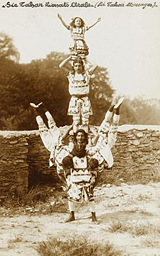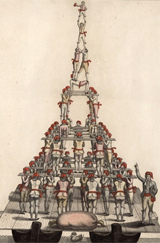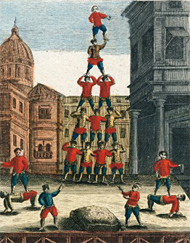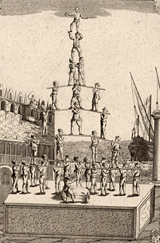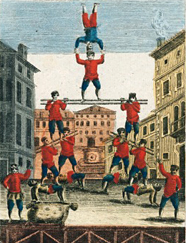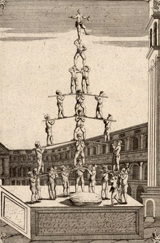Four grand traditions
by Gilles-Henri Polge
Human pyramids are a common practice in the world, but some have reached considerable heights. The Moroccans’ pyramids are performances, as much in their country as in our circuses. Others are popular games. The pyramids of the Mumbai region (India), have a goal: to recover the contents of a pot hanging over the street. Those of the Venetians, a tradition that has now disappeared, and those of the Catalans have no purpose, they are built for the sake of building. The Catalan castells have gone beyond the impossible and have reached 10 tiers high. All these constructions require a very elaborate technique, and have a specific vocabulary.
Morocco: The Human Pyramids of Oulad Ahmed Ou Moussa
On the Jamaa El Fna square in Marrakech, one can see traditional shows composed of dances and jumps, followed by human pyramids, punctuated by a specific music and acrobats in the traditional costume of red and green embroidered satin. They are members of an ancient brotherhood from southern Morocco: the Oulad Sidi Ahmed Ou Moussa, who made acrobatics their profession in the nineteenth century. Among their constructions is the Pyramid or Borj, which has as many tiers as elements at the base; The Door, or Tiflout, is a flat wall made up of columns, with the smaller acrobats suspended by their arms between each column; The Distance, or Ibbjaken, a flat wall that can be very long as it is made up of all the acrobats in the troupe with the individuals in the second tier standing on the thighs of those in the first tier whose legs are bent and spread wide.
In the 1820s, these Moroccan acrobats left to work in circuses in the United States, then in Europe, and from 1850 onwards in Germany in particular. Groups also practiced on the beaches of Tangiers, hoping to be noticed by showbusiness entrepreneurs. In the circus repertoire, they performed jumps, and exercises of V-shaped carrying: a single acrobat bearing many more above him.
Venice: The forces of Hercules
If we believe the mannerist engravings by Juste de Juste, of the school of Fontainebleau, or the "grotesques" decoration in the Sala dei Giocolieri at the castle of Torrechiara in Italy, the balancing games of men mounting one on top of the other already existed in the sixteenth century. The Forze d'Ercole (Forces of Hercules), Venetian human pyramids, were relatively simple at that time. Becoming more complex in the 18th century and including a large number of performers, they were built on platforms but also on small boats on the canals, or on the frozen lagoon. The participants carried bars on their shoulders to lend support to the entire construction. The base was called saorna, a marine term referring to the ballast thrown to the bottom of the sea; the tiers ageri; the men in the bridge position banchetti; the component at the top, the cimieretto; a man in an inverted position, impalo. The name of the pyramids was descriptive, for example Quarto di Rosetta sopra a banchetto, or, for the most part, symbolic, like L’Imperator superbo, or La Fondamenta dei Pensieri. Some constructions were attributed to the Nicolotti fishermen, others to the Castellani sailors, and some to both groups. The Anatra (the Duck pyramid), a construction of eight tiers constructed and dissembled without incident by the Castellani in 1806 on the Grand Canal, marked the height of the Forze d'Ercole, games that were banned indefinitely in 1816 due to unrest and fights that were sometimes fatal, due to the rivalry between the two groups. We know about the Forze d'Ercole games thanks to numerous visual and textual documents preserved among others at the Museo Correr, in Venice.
Mumbai (India): the human pyramids of the Janmasthani festival
There are several traditional dances that exist in India that include small human pyramids: the Daang dance, the Panthi dance, for example. But the large human pyramids are raised during the Janmasthani festival, or Gokulasthani, around August in the streets of Mumbai. We see them emerging from the crowd, which circles around the builders, the govindas, and encourages them with cries of "Govinda aale re". These pyramids are built by lots of men and boys, but also young girls, and now exclusively female troops also exist. Some reach up to nine tiers high. They have a purpose and a utility: to reach a pot, the dahi handi, hanging from a cable stretched across the street which the person at the top of the pyramid must break and whose contents, sour milk, puffed rice, and money, pours onto the builders. By moving from one place to another, the same troop can break up to 20 or 25 pots. The deconstruction of the pyramid is completed by jumping down. When the pyramid crumbles, sometimes the people at the top remain hooked in the air! The teams have an insurance contract for the top three tiers. In recent years, meetings, initiated by the Castellers troupe of Vilafranca, and technical exchanges are held in Mumbai and Catalonia, between the Govindas and the Castellers.
Catalonia: the human pyramids of the Falcons ... and those of the Castellers
On Sundays and certain holidays, except in winter, one can see human pyramids in the squares of the towns and villages of Catalonia. Those of the now famous Castellers, but also those of the Falcons, whose origins are in gymnastics: the first Falcons groups were created in 1932 after meets with the Czech gymnasts the Sokols (falcons). The Falcons build the Escala, a triangular wall; the Pira, in which the participants are arranged in a cross, two individuals facing each other bend over and lean on the shoulders of the two others below them; and the Piràmide drets, a tower that resembles the Moroccan constructions.
Some figures have points in common with the castells: thus, the Torreta is adapted from the Muixeranga of Algemisi, an ancient dance of religious origin which is concluded by a small tower and which would be the origin of the castells. In all of the Falcons’ figures, the person at the summit stands with arms spread out in a cross, mimicking the flight of the falcon; in the Torreta he balances on one leg.
The day when the actuació takes place in the city’s square one can see the Castellers arriving, preceded by the music of the Grallers. Men and women too, wear white trousers and the colour of their shirt indicates which troop, or colla, they are part of. Some arrive in a column one on top of the other; it is the pilar ambulante. Then the various constructions begin in the square with the pinya at their base on the ground: it is a mass of people assembled in a very technical way, but to which those members of the crowd who wish to participate can join themselves. A construction of two columns is called dos or torre; beyond this are the different castells (literally castles). The denomination of each construction is simple: the first number indicates the number of columns, the second the number of tiers, for example 3/8, "three of eight", means a tower of 3 columns on eight levels. We add the name of the buttress above the pinya, when there is one: folre on the 2nd tier, manilles on the 3rd. Since 1998, the tallest castells reach 10 tiers! The participants climb together tier by tier (some constructions are assembled from below, per sota). At the top of all the castells two children, the aixecador, squat down and lean forward – it is said that they "see the hole of hell", and incidentally they are the first ones to distinguish any weakness that might cause a collapse – and above them, the enxaneta, who crowns the construction and extends it towards the sky by raising an arm. At this moment, the construction is called carregat, completed. But it must still be descarregat, disassembled without falling, for the success to be complete. It is the whole process of construction and deconstruction that is interesting and moving to see, with the oscillation that moves constantly the along castell, the gradual rise, then the descent, fluid and fast, of the enxaneta, of the aixecador, and finally the tiers one after the other. The actuació, ends with the pillar al balcò: each colla raises a column that advances towards the ajuntament, the town hall, and the enxaneta is hoisted to the balcony by the city officials.



